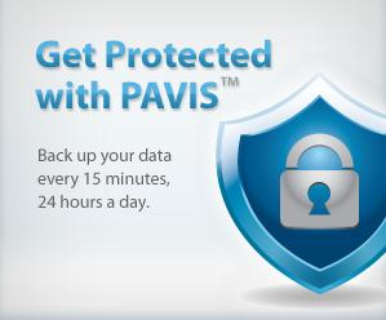Written by Brandon Garcin on Feb 29, 2016 6:00:00 AM on Continuum MSP Blog
Believe it or not, the first data backups were made on paper. Dating back as early as the 18th century, the “technology” was used in the form of paper tapes constructed from punch cards to control the functions of automated machinery such as textile looms. The concept of these cards was then further developed by IBM in the early days of data processing, where data input, storage and commands were captured using a series of hole punches.
 IBM Archives: https://www-03.ibm.com/ibm/history/exhibits/storage/storage_350.html
IBM Archives: https://www-03.ibm.com/ibm/history/exhibits/storage/storage_350.html
In 1956, IBM introduced the 350 disk storage unit – the first ever hard disk drive. It was 60 inches in length, stood nearly 70 inches tall and had a capacity of 5 million 6-bit characters – or 3.75 MB of data. And although less than 4 megabytes may not seem like much (a decent cell phone can today take a picture with a larger file size), the 350 unit represents a more modern concept of storage and data backup that over time has become a critical element of business planning and strategy.
Today, effective data backup encompasses far more than simply creating an extra copy of your most important files for redundancy in case something is lost or corrupt. The Web has given rise to a new era of always-on, 24x7x365 computing – and businesses today simply can’t afford to risk losing data.
The conversation now is about more than just data backup; it’s about business continuity.
The Need for Continuity
If a server crashes and an e-commerce website goes offline for a few hours, what would it cost the company? And what if transactional records were lost, or shipping data was compromised and deliveries were unable to make it to their destination? If data is lost at a hospital or healthcare facility and patient records are inaccessible, how can doctors administer proper care?
As information across all industries and businesses becomes increasingly digitized, the importance of ensuring that this information is continuously accessible has never been greater. And as storage technology has evolved from floppy disks to CD-ROMs, DVDs, portable hard drives and offsite cloud backup, the expectation of 24x7 uptime and constant availability certainly hasn’t slowed down.
Then there’s the matter of compliance and regulatory restrictions, which have become increasingly strict as both IT and business best practices have progressed. HIPAA, HITECH, PCI compliance, and myriad related requirements around data capture, storage, transfer and processing have forced backup vendors and technologies to shapeshift both point solutions and integrated software and services.
This notion of continuous uptime is at the core of modern business continuity. It’s about ensuring that in the case of a hardware failure, data corruption, or even a natural disaster that business operations can continue as though nothing had happened while recovery teams work to assess the damage and resolve whatever problem is occurring behind the scenes.
True business continuity requires careful planning and regular testing, and it’s not something that businesses should look to cut corners with. An effective business continuity plan is measured using metrics such as recovery time objective (RTO) and recovery point objective (RPO), which represent how quickly data can be recovered and how much data is at risk following any unplanned downtime.
What’s more, effective business continuity requires far more preparedness than traditional backup, and a more thoughtful approach than simply saying “we’ll call our backup vendor and they’ll take care of it”. A good offsite backup provider will be able to handle physical data recovery, server virtualization and other technical functions, but continuity planning also requires an organizational plan that ensures all employees are informed of the situation, key stakeholders understand their roles and responsibilities during and immediately following a data loss incident, and that any service level agreements are aligned with your recovery strategy to avoid any contractual or legal disputes with customers.
The Cloud Conversation
No conversation about business continuity today is complete without mentioning the cloud. Cloud computing and the ability to replicate data offsite have been absolute game-changers in the backup and disaster recovery market, and as the cloud becomes increasingly accessible – and more affordable – small businesses are able to tap into a growing list of benefits that were for a time available only to larger enterprise organizations. The cloud is also attractive because of its inherent flexibility and elasticity – it can be leveraged in a number of different ways, and resources can often be added or removed with the click of a mouse. Here’s a quick look at the three primary cloud types that are available today as they relate to continuity planning:
Public Cloud – In a public cloud, you’re purchasing storage capacity and resources from a third-party provider who’s maintaining the facilities, hardware and infrastructure where data actually resides. Think of it as renting a storage unit in a secure facility, or tapping into the electric grid that powers your home – resources are being shared, but you’ve got a piece of the pie that’s dedicated to your particular needs and can scale up or down as needed. An important note about public clouds is that because you’re not managing them yourself, it’s important to exercise due diligence to ensure that stability, accessibility and security requirements are all up to par before any data is uploaded.
Private Cloud – Conversely, a private cloud is entirely self-contained; storage capacity isn’t shared with other organizations, and hardware and infrastructure are owned and maintained by whoever owns the cloud itself. Rather than renting a storage unit or tapping into an electric grid, a private cloud is more akin to owning the storage facility itself or using a standalone generator for power. Though often more expensive, private clouds can be an attractive option for businesses who already possess the necessary hardware or who have highly-unique storage, compliance or regulatory needs that can’t easily be met by a public cloud provider.
Hybrid Cloud – As the name suggests, a hybrid cloud lives somewhere between its private and public counterparts. By leveraging a combination of on-premise, private cloud and public third-party services, with some level of connectivity and synchronization between them, hybrid deployments allow organizations to migrate data back and forth between private and public resources to respond to spikes in demand, evolving business requirements or fluctuating costs.
There is unique value and opportunity in each of these varieties of cloud, and no one-size-fits-all solution that’s right or wrong – businesses should carefully weigh the pros and cons of each before making a cloud investment. This is particularly true for small businesses, who may be able to see the value and the benefits presented by the cloud and business continuity but aren’t sure how best to tap into it; this is where managed IT service providers (MSPs) can step in and help.
Conclusion
Not long ago, storing a copy of your most important files on a portable hard drive or running a complete backup to a secondary server every now and then was considered effective backup. Today, these practices simply aren’t enough; businesses and their customers have grown to demand 24x7 uptime, accessibility and availability – and if an organization isn’t equipped to support true business continuity following any unplanned downtime, chances are there’s a competitor out there who is.
Organizations across nearly all industries today can’t afford to leave their data to chance – effective continuity planning is a must, and for those businesses unable to manage the process themselves, MSPs are in a prime position to step in and provide robust data storage, replication and recovery services.



